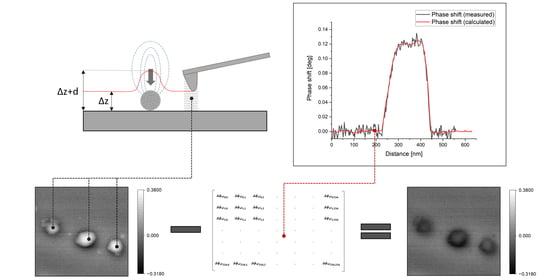Magnetic Imaging of Encapsulated Superparamagnetic Nanoparticles by Data Fusion of Magnetic Force Microscopy and Atomic Force Microscopy Signals for Correction of Topographic Crosstalk
Abstract
:1. Introduction
2. Materials and Methods
3. Theory
3.1. Capacitive Coupling
3.2. Data Fusion of AFM and MFM
4. Results and Discussion
4.1. Measurements on Non-Magnetic PS Nanoparticles in Comparison to Measurements on SPIONs
4.2. Measurements on SPIONs Encapsulated in PS
5. Conclusions
Author Contributions
Funding
Acknowledgments
Conflicts of Interest
References
- Yadav, H.K.S.; Almokdad, A.A.; Shaluf, S.I.M.; Debe, M.S. Polymer-based nanomaterials for drug-delivery carriers. In Nanocarriers for Drug Delivery; Elsevier: Amsterdam, The Netherlands, 2019; pp. 531–556. [Google Scholar]
- Din, F.U.; Aman, W.; Ullah, I.; Qureshi, O.S.; Mustapha, O.; Shafique, S.; Zeb, A. Effective use of nanocarriers as drug delivery systems for the treatment of selected tumors. Int. J. Nanomed. 2017, 12, 7291–7309. [Google Scholar] [CrossRef] [PubMed] [Green Version]
- Jose, J.; Kumar, R.; Harilal, S.; Mathew, G.E.; Parambi, D.G.T.; Prabhu, A.; Uddin, M.S.; Aleya, L.; Kim, H.; Mathew, B. Magnetic nanoparticles for hyperthermia in cancer treatment: An emerging tool. Environ. Sci. Pollut. Res. 2019, 27, 19214–19225. [Google Scholar] [CrossRef] [PubMed]
- Paysen, H.; Loewa, N.; Stach, A.; Wells, J.; Kosch, O.; Twamley, S.; Makowski, M.R.; Schaeffter, T.; Ludwig, A.; Wiekhorst, F. Cellular uptake of magnetic nanoparticles imaged and quantified by magnetic particle imaging. Sci. Rep. 2020, 10, 1–8. [Google Scholar] [CrossRef] [PubMed]
- Liu, J.; Yu, W.; Han, M.; Liu, W.; Zhang, Z.; Zhang, K.; Shi, J. A specific “switch-on” type magnetic resonance nanoprobe with distance-dominate property for high-resolution imaging of tumors. Chem. Eng. J. 2021, 404, 126496. [Google Scholar] [CrossRef]
- Schwarz, A.; Wiesendanger, R. Magnetic sensitive force microscopy. Nano Today 2008, 3, 28–39. [Google Scholar] [CrossRef]
- Collins, L.; Belianinov, A.; Proksch, R.; Zuo, T.; Zhang, Y.; Liaw, P.K.; Kalinin, S.V.; Jesse, S. G-mode magnetic force microscopy: Separating magnetic and electrostatic interactions using big data analytics. Appl. Phys. Lett. 2016, 108, 193103. [Google Scholar] [CrossRef]
- Raşa, M.; Philipse, A.P. Scanning probe microscopy on magnetic colloidal particles. J. Magn. Magn. Mater. 2002, 252, 101–103. [Google Scholar] [CrossRef] [Green Version]
- Paolino, P.; Tiribilli, B.; Bellon, L. Direct measurement of spatial modes of a microcantilever from thermal noise. J. Appl. Phys. 2009, 106, 094313. [Google Scholar] [CrossRef] [Green Version]
- Li, L.H.; Chen, Y. Electric contributions to magnetic force microscopy response from graphene and MoS2 nanosheets. J. Appl. Phys. 2014, 116, 213904. [Google Scholar] [CrossRef] [Green Version]
- Krivcov, A.; Schneider, J.; Junkers, T.; Möbius, H. Magnetic force microscopy of in a polymer matrix embedded single magnetic nanoparticles. Phys. Status Solidi 2019, 216, 1800753. [Google Scholar] [CrossRef]
- Krivcov, A.; Junkers, T.; Möbius, H. Understanding electrostatic and magnetic forces in magnetic force microscopy: Towards single superparamagnetic nanoparticle resolution. J. Phys. Commun. 2018, 2, 075019. [Google Scholar] [CrossRef]
- Passeri, D.; Dong, C.; Reggente, M.; Angeloni, L.; Barteri, M.; Scaramuzzo, F.A.; De Angelis, F.; Marinelli, F.; Antonelli, F.; Rinaldi, F.; et al. Magnetic force microscopy. Biomatter 2014, 4, e29507. [Google Scholar] [CrossRef] [PubMed] [Green Version]
- Fuhrmann, M.; Krivcov, A.; Musyanovych, A.; Thoelen, R.; Möbius, H. The role of nanoparticles on topographic cross-talk in electric force microscopy and magnetic force microscopy. Phys. Status Solidi 2020, 217, 1900828. [Google Scholar] [CrossRef]
- Angeloni, L.; Passeri, D.; Reggente, M.; Rossi, M.; Mantovani, D.; Lazzaro, L.; Nepi, F.; De Angelis, F.; Barteri, M. Experimental issues in magnetic force microscopy of nanoparticles. In Proceedings of the AIP Conference Proceedings; AIP Publishing LLC: Melville, NY, USA, 2015; Volume 1667, p. 020010. [Google Scholar]
- Das Neves, J.; Amiji, M.M.; Bahia, M.F.; Sarmento, B. Nanotechnology-based systems for the treatment and prevention of HIV/AIDS. Adv. Drug Deliv. Rev. 2010, 62, 458–477. [Google Scholar] [CrossRef] [PubMed]
- Yu, J.; Ahner, J.; Weller, D. Magnetic force microscopy with work function compensation. J. Appl. Phys. 2004, 96, 494–497. [Google Scholar] [CrossRef]
- Krivcov, A.; Ehrler, J.; Fuhrmann, M.; Junkers, T.; Möbius, H. Influence of dielectric layer thickness and roughness on topographic effects in magnetic force microscopy. Beilstein J. Nanotechnol. 2019, 10, 1056–1064. [Google Scholar] [CrossRef] [PubMed] [Green Version]
- Angeloni, L.; Passeri, D.; Reggente, M.; Mantovani, D.; Rossi, M. Removal of electrostatic artifacts in magnetic force microscopy by controlled magnetization of the tip: Application to superparamagnetic nanoparticles. Sci. Rep. 2016, 6, 26293. [Google Scholar] [CrossRef] [PubMed] [Green Version]
- Musyanovych, A.; Rossmanith, R.; Tontsch, C.; Landfester, K. Effect of hydrophilic comonomer and surfactant type on the colloidal stability and size distribution of carboxyl-and amino-functionalized polystyrene particles prepared by miniemulsion polymerization. Langmuir 2007, 23, 5367–5376. [Google Scholar] [CrossRef] [PubMed]
- Ramírez, L.P.; Landfester, K. Magnetic polystyrene nanoparticles with a high magnetite content obtained by miniemulsion processes. Macromol. Chem. Phys. 2003, 204, 22–31. [Google Scholar] [CrossRef]







Publisher’s Note: MDPI stays neutral with regard to jurisdictional claims in published maps and institutional affiliations. |
© 2020 by the authors. Licensee MDPI, Basel, Switzerland. This article is an open access article distributed under the terms and conditions of the Creative Commons Attribution (CC BY) license (http://creativecommons.org/licenses/by/4.0/).
Share and Cite
Fuhrmann, M.; Musyanovych, A.; Thoelen, R.; von Bomhard, S.; Möbius, H. Magnetic Imaging of Encapsulated Superparamagnetic Nanoparticles by Data Fusion of Magnetic Force Microscopy and Atomic Force Microscopy Signals for Correction of Topographic Crosstalk. Nanomaterials 2020, 10, 2486. https://0-doi-org.brum.beds.ac.uk/10.3390/nano10122486
Fuhrmann M, Musyanovych A, Thoelen R, von Bomhard S, Möbius H. Magnetic Imaging of Encapsulated Superparamagnetic Nanoparticles by Data Fusion of Magnetic Force Microscopy and Atomic Force Microscopy Signals for Correction of Topographic Crosstalk. Nanomaterials. 2020; 10(12):2486. https://0-doi-org.brum.beds.ac.uk/10.3390/nano10122486
Chicago/Turabian StyleFuhrmann, Marc, Anna Musyanovych, Ronald Thoelen, Sibylle von Bomhard, and Hildegard Möbius. 2020. "Magnetic Imaging of Encapsulated Superparamagnetic Nanoparticles by Data Fusion of Magnetic Force Microscopy and Atomic Force Microscopy Signals for Correction of Topographic Crosstalk" Nanomaterials 10, no. 12: 2486. https://0-doi-org.brum.beds.ac.uk/10.3390/nano10122486






